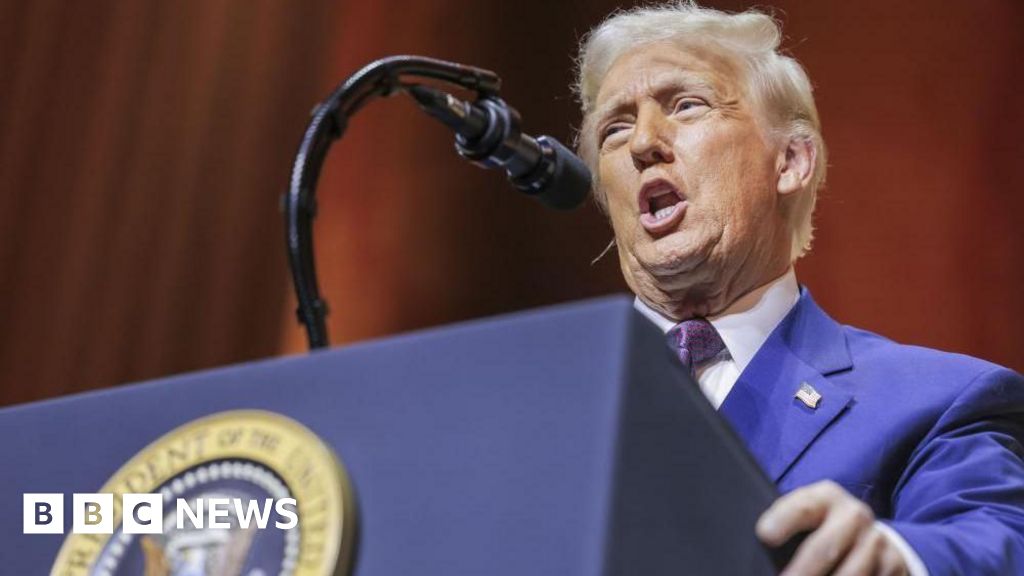
Discover why the Trump Administration is rebranding the Pentagon into the Department of War. Explore motives, risks, legal implications, media reactions, and what it means for U.S. defense policy in 2025.
In September 2025, the Trump administration issued an executive order rebranding the U.S. Department of Defense as the “Department of War.” This symbolic yet politically charged move aims to reshape the Pentagon’s public image, military philosophy, and strategic narrative. The implications stretch across law, foreign policy, and institutional identity.
A War of Words or a Redefinition of Power?
In the realm of politics and perception, words wield enormous power. When President Donald Trump signed Executive Order 14347 in September 2025, renaming the Department of Defense to the Department of War, it set off shockwaves across Washington and the world.
At first glance, it may appear like a superficial name change — but in the language of governance and geopolitics, a name can shape an entire narrative. The rebranding of the Pentagon is not only symbolic; it carries implications for military identity, national psychology, and global diplomacy.
In this article, we explore why the Trump administration is rebranding the Pentagon, what the change entails, and how it could alter the United States’ strategic and cultural landscape.
What Exactly Is Changing Under the Pentagon’s Rebranding?
Executive Order 14347: The Core Directive
President Trump’s Executive Order 14347, titled “Restoring the United States Department of War”, mandates that the Pentagon resume using the name “Department of War” in official communication and branding.
Although the Department of Defense remains the statutory name until Congress changes it by law, the order allows the government to adopt “Department of War” as a ceremonial title.
Key immediate changes include:
- The official website defense.gov now redirects to war.gov.
- New communications and joint military documents reference “Department of War.”
- The White House restructured its National Security Council’s Defense Directorate into the “War Directorate.”
However, these actions are symbolic rather than legal. Only Congress has the authority to officially rename a federal department.

Institutional and Structural Shifts
The rebranding isn’t limited to signage or stationery. It’s part of a wider cultural and ideological transformation within the Pentagon.
Notable changes include:
- Visual Identity: Logos, seals, and military patches are being redesigned to feature the term “War.”
- Language Shift: Internal communications emphasize “lethality,” “combat readiness,” and “warrior culture.”
- Command Centralization: The new War Directorate within the White House consolidates defense planning under tighter executive control.
These developments suggest that the rebrand is a step toward reasserting direct presidential influence over the military’s identity and messaging.
Why Is the Trump Administration Doing This Now?
To grasp the motives, we must view the rebrand through multiple lenses — political, ideological, and psychological. The move intertwines symbolic aggression with campaign strategy and institutional restructuring.
1. Signaling Strength and Reasserting a Warrior Identity
The Trump administration views the term “Defense” as passive and politically correct — a product of what they call the “woke era” of U.S. governance.
In his speech announcing the executive order, Trump stated:
“We won the first world war, we won the second world war … Then we decided to go woke and changed the name to the Department of Defense.”
By returning to the Department of War, Trump seeks to project strength, aggression, and unapologetic militarism — values that resonate with his political base.
2. Rejecting “Woke” Ideology and Modern Defense Culture
The rebrand is part of a broader ideological campaign to purge “woke” culture from government institutions.
Over recent months, the administration has:
- Reduced funding for diversity and inclusion programs.
- Ordered reviews of “politically biased” materials in military academies.
- Promoted a return to “traditional warrior values.”
In this sense, the Pentagon’s rebranding is both a political message and a cultural purge — an attempt to align military identity with conservative values.
3. Building Political Momentum Ahead of Elections
From a campaign strategy perspective, the rebrand offers a simple, emotive slogan: “We’re not defending — we’re winning wars.”
It’s a rallying cry for voters who value assertiveness and dominance. The move plays directly into populist sentiment — transforming a bureaucratic change into a symbolic declaration of power.
4. Centralizing Control Under the Executive Branch
The rebrand coincides with structural reforms designed to consolidate military planning within the executive branch.
The new War Directorate, reporting directly to the White House, streamlines decision-making and aligns messaging across agencies. Critics warn that this undermines the National Security Council’s role as an independent coordinator.
5. Redirecting Media Attention
Rebrands can be tools of distraction. Amid controversies over foreign aid, intelligence leaks, and military budget overruns, the administration’s focus on renaming the Pentagon shifts the media narrative.
The “War Department” conversation dominates headlines — drawing attention away from other policy disputes.
6. Nostalgia and Historical Myth-Building
The rhetoric around this rebrand is nostalgic — invoking the U.S. military’s “glory days” from the World War II era.
The term “Department of War” symbolizes decisive victories and national unity, appealing to older voters and patriotic demographics.
It reframes defense policy in the language of “heroism over bureaucracy.”
What Are the Legal, Financial, and Institutional Risks?
While the rebranding may appear symbolic, it raises serious practical and constitutional concerns.
Legal Boundaries
- Congressional Authority: Only Congress can legally change the name of the Department of Defense under Title 10 of the U.S. Code.
- Executive Limitations: The president can only influence internal naming conventions, not statutory identities.
- Litigation Risk: Legal experts anticipate lawsuits alleging executive overreach and administrative confusion.
Financial Costs
Rebranding the Pentagon involves immense logistical expense. Updating signs, seals, uniforms, websites, and printed materials globally could cost hundreds of millions of dollars.
Critics call it an “expensive publicity stunt” that diverts taxpayer money from readiness programs and veterans’ benefits.
Institutional Resistance
Behind closed doors, many senior military officials are skeptical.
The armed forces traditionally avoid political entanglements, and some see this rebranding as a politicization of military identity.
Several retired generals have publicly warned that the move could undermine morale and erode civilian trust in the military.
Diplomatic & Strategic Fallout
Allies interpret the rebranding as an aggressive shift in U.S. foreign posture.
Diplomats from NATO, Japan, and Germany have quietly expressed concern that this signals a return to unilateralism and militarized diplomacy.
Public Perception Challenges
For many Americans, the word “war” evokes decades of loss and fatigue — from Vietnam to Iraq.
Reintroducing it in the Pentagon’s name could alienate moderate voters and rekindle anti-war sentiment at home.

Historical Context: From “War” to “Defense” — and Back Again
The United States originally operated under a Department of War (1789–1947). After World War II, the National Security Act of 1947 reorganized the military under the new Department of Defense, symbolizing a move from perpetual warfare to strategic deterrence.
Trump’s decision to resurrect the old name thus represents a deliberate reversal of post-war ideals — reviving the rhetoric of conquest rather than protection.
International Parallels
Historically, militarized regimes like Imperial Japan, Nazi Germany, and the Soviet Union used “War” ministries.
Modern democracies shifted to “Defense” or “Armed Forces” to reflect a defensive, collaborative security stance.
Reverting to “War” repositions the U.S. closer to the rhetoric of dominance, not deterrence — a shift with profound diplomatic implications.
How the Public and Media Are Reacting
Media Backlash
Following the rebrand, the Pentagon introduced new press access rules requiring journalists to sign loyalty-based access pledges.
Over 30 major U.S. news outlets, including Reuters, AP, and The Washington Post, refused to comply, calling the rules “a direct threat to press freedom.”
Congressional Divide
- Republican Support: Conservative lawmakers praised the move as a “return to strength.”
- Democratic Opposition: Democrats criticized it as “dangerous branding” and “constitutional theater.”
Several members of Congress, including Sen. Mike Lee, proposed legislation to formalize the change, but legal analysts expect fierce debate in both chambers.
Military & Veteran Responses
The reaction from the military community is mixed.
Many veterans support the symbolic return to “warrior culture,” but active-duty officers express discomfort with the political tone.
For some, it’s a rallying symbol of pride.
For others, a sign of creeping politicization.
10 Trending FAQs About the Pentagon Rebranding
Q1. Can the president rename the Pentagon by executive order?
Answer: No. The president can direct agencies on internal naming conventions, but only Congress can change the legal name of a federal department via statute. The current executive order makes “Department of War” a ceremonial or secondary title. Until Congress passes a renaming law, “Department of Defense” remains the statutory name.
Q2. Why does it matter if the name is “Defense” vs “War”?
Answer: Names carry narrative weight. “Defense” suggests protection, deterrence, and restraint; “War” emphasizes offense, combat, and confrontation. This rebrand signals a shift in mindset—not just semantics—and sets expectations for future military posture and doctrine.
Q3. What are the financial costs of rebranding?
Answer: While estimates vary, changing signs, patches, IDs, websites, uniforms, seals, letterheads, and infrastructure globally could cost hundreds of millions. Some critics call it wasteful political theater. Wikipedia+2thewellnews.com+2
Q4. How have U.S. military and defense officials responded?
Answer: Some have expressed private skepticism, viewing the move as symbolic rather than substantive. Others have embraced the rhetoric. Public statements are cautious—the military prefers institutional continuity over political dramatics.
Q5. What are the implications for allies and defense treaties?
Answer: Allies may worry that the name shift signals a return to unilateral, aggressive U.S. posture rather than multilateral coordination. Some treaties or joint statements might need reinterpretation. Communications channels might be strained by perception.
Q6. Does this rebranding affect nuclear or warpowers doctrine?
Answer: Not immediately. War powers, nuclear posture, and defense strategy are governed by law, doctrine, and treaty. The rebrand does not inherently change those frameworks—but it may presage shifts in policy or signaling.
Q7. How does this rebranding interact with press freedom and transparency?
Answer: It coincides with tougher press rules at the Pentagon. Journalists must now sign access pledges and face restrictions. Over 30 major news outlets have refused. Critics say it’s a move to centralize narrative control. Reuters+2TIME+2
Q8. Could this move provoke a constitutional challenge?
Answer: Yes. Legal challenges may argue executive overreach, First Amendment violations (via press rules), and conflicts with Congressional authority. Courts will likely need to adjudicate how far a rebrand can go.
Q9. Do other countries maintain “war ministries”?
Answer: Some do. For example, historically many states used “War Ministry” or “Ministry of War.” Today, many use terms like “Ministry of Defense,” “Ministry of Armed Forces,” or “Ministry of National Security,” which soften the tone and better reflect multiple defense dimensions.
Q10. What should citizens watch moving forward?
Answer:
- Whether Congress passes legislation to formalize the name change
- Legal appeals challenging press and executive limits
- Budget lines shifting to offensive military programs
- Adjustments in doctrine, alliances, and war planning
- Public polling responses to the rhetoric over time
Key Takeaways
- The rebranding is largely symbolic but politically strategic.
- Only Congress can officially rename the Department of Defense.
- The move reflects a shift in national narrative — from protection to projection.
- Media pushback and legal scrutiny are mounting.
- Citizens should monitor how doctrine and policy evolve under this new identity.
Final Word
The Pentagon’s rebranding under the Trump administration is far more than a cosmetic makeover — it’s a battle over language, legacy, and leadership.
By resurrecting the “Department of War,” the administration is redefining America’s self-image as a nation not merely on guard, but on the offensive.
Whether history views it as a visionary reclamation or a dangerous regression will depend on what follows — actions, not just words.
